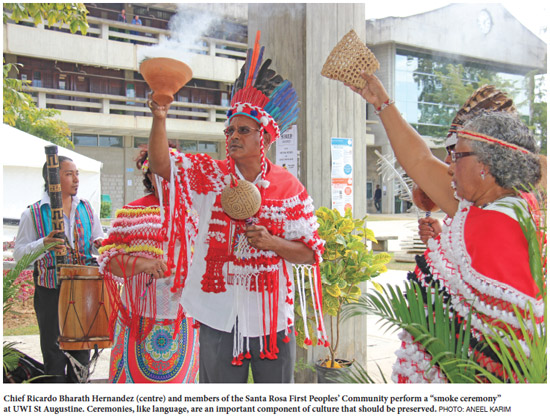|
February 2019

Issue Home >>
|

 Once upon a time, before the arrival of Europeans, Trinidad had at least 11 autochthonous or indigenous (so-called Amerindian) languages. Five of those languages belonged to the Carib or Cariban family – only Kalina (Carib) is alive. Three belonged to the Ta-Arawakan or Ta-Maipurean family – only Lokono (Arawak) is alive. Of three from other language families, only Warao is alive. The others are now extinct. Once upon a time, before the arrival of Europeans, Trinidad had at least 11 autochthonous or indigenous (so-called Amerindian) languages. Five of those languages belonged to the Carib or Cariban family – only Kalina (Carib) is alive. Three belonged to the Ta-Arawakan or Ta-Maipurean family – only Lokono (Arawak) is alive. Of three from other language families, only Warao is alive. The others are now extinct.
The death of a language is a great loss. A people’s language is a critical component of their culture, identity and daily lives. In recognition of this, and in an effort to increase awareness of the importance of language preservation and documentation, UNESCO has proclaimed 2019 the International Year of Indigenous Languages (IYIL2019).
Launched on 28 January of this year, IYIL2019 is a worthwhile and timely initiative, with great relevance to the Caribbean, both the archipelago and the rimlands.
Language Death
The insular Caribbean archipelago was once described as a “linguistic graveyard” by UWI Professor Emeritus Mervyn C. Alleyne (1933–2016). A longstanding intolerance towards multilingualism developed in most Caribbean territories during colonial times. As a result of language policies, whether socially, educationally or legally enforced, nearly all of the Amerindian languages have disappeared from the Caribbean island chain. Surviving indigenous languages of the Continental or Greater Caribbean and the rest of the Americas also continue to face similar threats.
Of the Cariban languages once in vigorous use here, Kalina has 7,500 speakers across Venezuela, Guyana, Suriname, French Guiana and Brazil. (The other four Cariban languages, Carinepagoto, Chaima, Nepoio and Yao are all described as extinct.) Of the Arawakan languages, Lokono has 2,500 speakers across Venezuela, Guyana, Suriname and French Guiana. (The other two, Shebaio and Igneri are extinct.) Warao, a language isolate, is the most widely spoken indigenous language in the Orinoco Delta, with 33,000 speakers across Venezuela, Trinidad, Guyana and Suriname. Although so many languages – including Kalipunian and Chaguane – are extinct, their speakers may well have descendants among us today.
In the face of the destruction of the original linguistic ecology of the Caribbean, charting the history of the dying and extinct languages of the Americas sensitises us to deal with issues of language planning, and helps us to know, document and save the languages we still have, including the ones that are endangered.
Language Vitality
For the Americas in general, Ethnologue estimates that there are 1,060 living languages, 650 or 61% of which are described as In Trouble and Dying—most are Amerindian. These categories of Language Vitality are among those used in the Expanded Graded Intergenerational Disruption Scale (Lewis and Simons 2010), a useful and detailed 13-tiered measurement system ranging from international to extinct (with a 14th category of forgotten, off the scale).
Ethnologue catalogues only 23 languages for the Caribbean, but there are over 70, including overlooked and under-described home-grown Creole languages and sign languages. Counting all the countries with a Caribbean coast would bring the number of living languages up to some 245 – most are Amerindian.
The most visible linguistic legacy of the First Peoples of Trinidad and Tobago remains the over 200 toponyms all over both islands, and some flora, fauna and words in other domains. A 1986 Society for Caribbean Linguistics conference paper by Rawwida Baksh-Soodeen and Arie Boomert notes, “While this figure (200) may seem small, it actually represents some 450 place names since a single name may signify as many as five to six different situations such as point, bay, river, town, village, mountain, road, county or forest reserve. What is also significant is that the bulk of the island’s main topographical features carry Amerindian names”.
Looking to the Future
All is not lost. Using tools of Anthropological Linguistics, Sociolinguistics, Contact Linguistics, Language Documentation, Historical and Comparative Linguistics, Etymology, Linguistic Landscape, Language Acquisition and Reclamation, History and Archaeology, it is possible for us not only to reckon with the past and understand the present, but to move forward into the future. The future must include a place for West Indian and Caribbean languages at West Indian and Caribbean institutions.
Congratulations to UNESCO for proclaiming 2019 as the Year of Indigenous Languages. We look forward to celebrating our intangible, indigenous, linguistic heritage throughout the year. International Mother Language Day will be held on 21 February and International Day of the World’s Indigenous Peoples on 9 August. Visit https://en.iyil2019.org/ for more information on worldwide commemorations.
Dr Jo-Anne S. Ferreira is Senior Lecturer in Linguistics and Head of the Department of Modern Languages and Linguistics, and President of the Society for Caribbean Linguistics.
|





